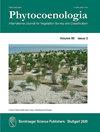European Mire Vegetation Database: a gap-oriented database forEuropean fens and bogs
IF 0.9
4区 生物学
Q4 ECOLOGY
引用次数: 14
Abstract
The attempt to produce a harmonized classification of European mires and to conduct a syntaxonomical analysis on the basis of individual releves has led to the creation of the European Mire Vegetation Database (GIVD ID: EU-00-022, http://www.givd.info/ID/EU-00-022). The database is managed by the Mire Ecology Working Group (Department of Botany and Zoology, Masaryk University, Brno). In May 2015 this database was comprised of 10,147 releves of the classes Scheuchzerio palustris-Caricetea nigrae and Oxycocco-Sphagnetea published in various monographs, manuscripts or journals, but not stored in any other national or regional electronic vegetation databases. Only releves where bryophytes were identified as well as vascular plants were computerized. Most of the newly digitized data are from Northern and Southeastern European regions. Geographical coordinates are available for individual vegetation plots, their accuracy depends on the precision of the location description given. The European Mire Vegetation Database has been integrated in the European Vegetation Archive as a repository of mire vegetation not included in other national or regional databases.欧洲沼泽植被数据库:一个面向空白的欧洲沼泽和沼泽数据库
为了对欧洲沼泽进行统一分类,并在个别沼泽的基础上进行分类学分析,建立了欧洲沼泽植被数据库(GIVD ID: EU-00-022,http://www.givd.info/ID/EU-00-022)。该数据库由沼泽生态工作组(布尔诺马萨里克大学植物与动物学系)管理。2015年5月,该数据库由10,147个Scheuchzeriopalustris-Caricetea nigrae和Oxycocco-Sphagnetea类组成,发表了各种专著、手稿或期刊,但未存储在任何其他国家或地区的电子植被数据库中。只有在苔藓植物和维管植物同时被识别的地方才被计算机化。大多数新数字化的数据来自北欧和东南欧地区。地理坐标可用于单个植被图,其精度取决于所给出的位置描述的精度。欧洲沼泽植被数据库已被纳入欧洲植被档案,作为其他国家或地区数据库中未包括的沼泽植被库。
本文章由计算机程序翻译,如有差异,请以英文原文为准。
求助全文
约1分钟内获得全文
求助全文
来源期刊

Phytocoenologia
生物-植物科学
CiteScore
2.60
自引率
0.00%
发文量
7
审稿时长
>12 weeks
期刊介绍:
Phytocoenologia is an international, peer-reviewed journal of plant community ecology. It is devoted to vegetation survey and classification at any organizational and spatial scale and without restriction to certain methodological approaches. The journal publishes original papers that develop new vegetation typologies as well as applied studies that use such typologies, for example, in vegetation mapping, ecosystem modelling, nature conservation, land use management or monitoring. Particularly encouraged are methodological studies that design and compare tools for vegetation classification and mapping, such as algorithms, databases and nomenclatural principles. Papers dealing with conceptual and theoretical bases of vegetation survey and classification are also welcome. While large-scale studies are preferred, regional studies will be considered when filling important knowledge gaps or presenting new methods.
 求助内容:
求助内容: 应助结果提醒方式:
应助结果提醒方式:


